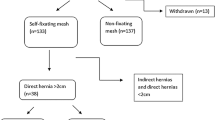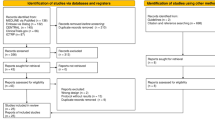Abstract
Purpose
The association of postoperative patient-reported outcomes and type of mesh fixation during minimally invasive inguinal hernia repair has not been well characterized. We aimed to compare the 30-day quality of life outcomes between various mesh fixation techniques utilizing the AHSQC prospective registry.
Methods
All minimally invasive inguinal hernias with completed 30-day follow-up were abstracted from the AHSQC, excluding patients with primary indication for surgery being chronic groin pain. Mesh fixation was categorized as (1) atraumatic fixation (AF) (2) traumatic non-suture (TNS), (3) traumatic suture (TS). Our outcomes of interest were pain at site at 30-day and EuraHS quality of life assessment.
Results
After applying inclusion and exclusion criteria, 864 patients had surgical site pain and quality of life outcomes reported; 253 (AF), 451 (TNS), and 160 (TS). After adjusting for identified confounders, there was no statistically significant difference between any fixation method when evaluating pain as a binary variable (Yes/No). However, when looking at the EuraHS evaluation for pain and quality of life outcomes, AF was associated with better scores than both TNS and TS fixation in the cosmetic, restrictions, and overall EuraHS domains. AF was only better than TS fixation in the pain domain.
Conclusion
Our study suggests that AF had a significantly improved hernia-specific quality of life in all domains at 30-days postoperatively. We also identified that pain as a binary variable is inadequate for its states purpose. Thus, the overall well-being and morbidity should be taken into account when evaluating hernia patients postoperatively.

Similar content being viewed by others
References
McCormack K, Scott N, Go P et al (2008) Laparoscopic techniques versus open techniques for repair of a hernia in the groin. Cochrane Database Syst Rev. https://doi.org/10.1002/14651858.CD001785.www.cochranelibrary.com
Köckerling F, Bittner R, Jacob DA et al (2015) TEP versus TAPP: comparison of the perioperative outcome in 17,587 patients with a primary unilateral inguinal hernia. Surg Endosc 29:3750–3760. https://doi.org/10.1007/s00464-015-4150-9
Muysoms F, Campanelli G, Champault GG et al (2012) EuraHS: the development of an international online platform for registration and outcome measurement of ventral abdominal wall hernia repair. Hernia 16:239–50. https://doi.org/10.1007/s10029-012-0912-7
Lowham AS, Filipi CJ, Fitzgibbons RJ et al (1997) Mechanisms of hernia recurrence after preperitoneal mesh repair: traditional and laparoscopic. Ann Surg. https://doi.org/10.1097/00000658-199704000-00012
Brügger L, Bloesch M, Ipaktchi R et al (2012) Objective hypoesthesia and pain after transabdominal preperitoneal hernioplasty: a prospective, randomized study comparing tissue adhesive versus spiral tacks. Surg Endosc 26:1079–1085. https://doi.org/10.1007/s00464-011-2003-8
Stark E, Oestreich K, Wendl K et al (1999) Nerve irritation after laparoscopic hernia repair. Surg Endosc 13:878–881. https://doi.org/10.1007/s004649901124
Prakash PS, Wijerathne S, Salgaonkar HP, Lomanto D (2019) The efficacy of absorbable versus non-absorbable fixation in laparoscopic totally extraperitoneal (tep) repair of large inguinal hernias. Asian J Surg. https://doi.org/10.1016/j.asjsur.2019.01.010
HerniaSurge, Group (2018) International guidelines for groin hernia management. Hernia 22:1–165. https://doi.org/10.1007/s10029-017-1668-x
Topart P, Vandenbroucke F, Lozac’h P (2005) Tisseel vs tack staples as mesh fixation in totally extraperitoneal laparoscopic repair of groin hernias: a retrospective analysis. Surg Endosc Other Interv Tech. https://doi.org/10.1007/s00464-004-8812-2
Lovisetto F, Zonta S, Rota E et al (2007) Use of human fibrin glue (Tissucol) versus staples for mesh fixation in laparoscopic transabdominal preperitoneal hernioplasty: a prospective, randomized study. Ann Surg. https://doi.org/10.1097/01.sla.0000245832.59478.c6
Lau H (2005) Fibrin sealant versus mechanical stapling for mesh fixation during endoscopic extraperitoneal inguinal hernioplasty: a randomized prospective trial. Ann Surg. https://doi.org/10.1097/01.sla.0000186440.02977.de
Poulose BK, Roll S, Murphy JW et al (2016) Design and implementation of the Americas Hernia Society Quality Collaborative (AHSQC): improving value in hernia care. Hernia 20:177–189. https://doi.org/10.1007/s10029-016-1477-7
Muysoms FE, Vanlander A, Ceulemans R et al (2016) A prospective, multicenter, observational study on quality of life after laparoscopic inguinal hernia repair with ProGrip laparoscopic, self-fixating mesh according to the European Registry for Abdominal Wall Hernias Quality of Life Instrument. Surg (United States) 160:1344–1357. https://doi.org/10.1016/j.surg.2016.04.026
Tastaldi L, Haskins IN, Perez AJ et al (2017) Single center experience with the modified retromuscular Sugarbaker technique for parastomal hernia repair. Hernia 21:941–949. https://doi.org/10.1007/s10029-017-1644-5
Choi BJ, Jeong WJ, Lee SC (2018) Fibrin glue versus staple mesh fixation in single-port laparoscopic totally extraperitoneal inguinal hernia repair: a propensity score-matched analysis. Int J Surg. https://doi.org/10.1016/j.ijsu.2018.01.029
Tolver MA, Rosenberg J, Juul P, Bisgaard T (2013) Randomized clinical trial of fibrin glue versus tacked fixation in laparoscopic groin hernia repair. Surg Endosc 27:2727–2733. https://doi.org/10.1007/s00464-012-2766-6
Smith AI, Royston CMS, Sedman PC (1999) Stapled and nonstapled laparoscopic transabdominal preperitoneal (TAPP) inguinal hernia repair: a prospective randomized trial. Surg Endosc. https://doi.org/10.1007/s004649901104
Teng YJ, Pan SM, Liu YL et al (2011) A meta-analysis of randomized controlled trials of fixation versus nonfixation of mesh in laparoscopic total extraperitoneal inguinal hernia repair. Surg Endosc 25:2849–2858. https://doi.org/10.1007/s00464-011-1668-3
Antoniou SA, Köhler G, Antoniou GA et al (2016) Meta-analysis of randomized trials comparing nonpenetrating vs mechanical mesh fixation in laparoscopic inguinal hernia repair. Am J Surg 211:239–249.e2. https://doi.org/10.1016/j.amjsurg.2015.06.008
Lederhuber H, Stiede F, Axer S, Dahlstrand U (2017) Mesh fixation in endoscopic inguinal hernia repair: evaluation of methodology based on a systematic review of randomised clinical trials. Surg Endosc 31:4370–4381. https://doi.org/10.1007/s00464-017-5509-x
Olmi S, Scaini A, Erba L et al (2007) Quantification of pain in laparoscopic transabdominal preperitoneal (TAPP) inguinal hernioplasty identifies marked differences between prosthesis fixation systems. Surgery 142:40–46. https://doi.org/10.1016/j.surg.2007.02.013
Wright JG (1999) Outcomes research: What to measure. World J Surg 23:1224–1226. https://doi.org/10.1007/s002689900652
Loos MJA, Houterman S, Scheltinga MRM, Roumen RMH (2008) Evaluating postherniorrhaphy groin pain: visual analogue or verbal rating scale? Hernia 12:147–151. https://doi.org/10.1007/s10029-007-0301-9
Bowley DMG, Butler M, Shaw S, Kingsnorth AN (2003) Dispositional pessimism predicts delayed return to normal activities after inguinal hernia operation. Surgery 133:141–146. https://doi.org/10.1067/msy.2003.34
Tam K-W, Lang H-H, Chai C-Y (2010) Outcomes of staple fixation of mesh versus nonfixation in laparoscopic total extraperitoneal inguinal repair: a meta-analysis of randomized controlled trials. World J Surg 34:3065–3074. https://doi.org/10.1007/s00268-010-0760-5
Sajid MS, Ladwa N, Kalra L et al (2013) A meta-analysis examining the use of tacker mesh fixation versus glue mesh fixation in laparoscopic inguinal hernia repair. Am J Surg 206:103–111. https://doi.org/10.1016/j.amjsurg.2012.09.003
Taylor RS, Ullrich K, Regan S et al (2013) The impact of early post-operative pain on health-related quality of life. Pain Pract 13:515–523. https://doi.org/10.1111/papr.12026
Ip HYV, Abrishami A, Peng PWH et al (2009) Predictors of postoperative pain and analgesic consumption. Anesthesiology 111:657–677. https://doi.org/10.1097/aln.0b013e3181aae87a
Van Boekel RLM, Vissers KCP, Van Der Sande R et al (2017) Moving beyond pain scores: multidimensional pain assessment is essential for adequate pain management after surgery. PLoS ONE One 12:1–16. https://doi.org/10.1371/journal.pone.0177345
Funding
This research did not receive any specific grant from funding agencies in the public, commercial, or not-for-profit sectors.
Author information
Authors and Affiliations
Corresponding author
Ethics declarations
Conflict of interest
Author MR reports receiving salary support for role as medical director of the non-profit AHSQC, relevant to the work, as well as board membership of Ariste Medical and grants to the Cleveland Clinic Institution from Intuitive, Pacira, and Miromatrix, outside the submitted work. Author AP reports grants to the Cleveland Clinic Institution from Intuitive, and personal fees from MedTronic and Bard Davol, outside the submitted work. Author DK reports educational grants to the Cleveland Clinic Institution, outside of the submitted work. Authors LC and SP report that the AHSQC has contracted with Vanderbilt Biostatistics to provide support for AHSQC projects and the work provided was performed under the umbrella of the AHSQC-Vanderbilt Biostatistics collaboration plan, relevant to the work. Authors LT and AF report resident research grants from the AHSQC, outside the submitted work. All other authors declare that they have no conflict of interest.
Ethical approval
All procedures related to this study were compliant with current US law. All procedures performed in studies involving human participants were in accordance with the ethical standards of the institutional research committee and with the 1964 Helsinki Declaration and its later amendments or comparable ethical standards.
Human and animal rights
This article does not contain any studies with human participants or animals performed by any of the authors.
Informed consent
The project only involved analysis of exisitng de-identified data, informed concent was waived.
Additional information
Publisher's Note
Springer Nature remains neutral with regard to jurisdictional claims in published maps and institutional affiliations.
Rights and permissions
About this article
Cite this article
Tish, S., Krpata, D., AlMarzooqi, R. et al. Comparing 30-day outcomes between different mesh fixation techniques in minimally invasive inguinal hernia repair. Hernia 24, 961–968 (2020). https://doi.org/10.1007/s10029-020-02123-8
Received:
Accepted:
Published:
Issue Date:
DOI: https://doi.org/10.1007/s10029-020-02123-8




